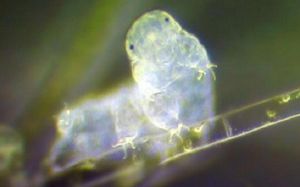(Created page with "'''Tardigrades''' are microscopic animals popularly known as '''water bears''' and truly remarkable for their high resistance to extreme environments such as freezing, boiling water, starvation for decades... these are conditions where other life forms would not resist. This is made possible by their ability to shut down their organs when environmental conditions are not suitable (an ametabolic state called anhydrobiosis) and come back to life when optimal conditions ar...") |
No edit summary |
||
| Line 1: | Line 1: | ||
'''Tardigrades''' are microscopic animals popularly known as '''water bears''' and truly remarkable for their high resistance to extreme environments such as freezing, boiling water, starvation for decades... these are conditions where other life forms would not resist. | [[File:14528515709033 546x0.jpg|thumb]] | ||
'''Tardigrades''' are microscopic animals (500 µm on average) popularly known as '''water bears''' and truly remarkable for their high resistance to extreme environments such as freezing, boiling water, starvation for decades... these are conditions where other life forms would not resist. | |||
This is made possible by their ability to shut down their organs when environmental conditions are not suitable (an ametabolic state called anhydrobiosis) and come back to life when optimal conditions are restored. | This is made possible by their ability to shut down their organs when environmental conditions are not suitable (an ametabolic state called anhydrobiosis) and come back to life when optimal conditions are restored. | ||
One of the reasons these organisms are so resilient is because of a protein that only they produce. These abundant heat-soluble cytoplasmic proteins (CAHS) cause the inside of the cells to turn into a gel, which prevents the cell from collapsing. | One of the reasons these organisms are so resilient is because of a protein that only they produce. These abundant heat-soluble cytoplasmic proteins (CAHS) cause the inside of the cells to turn into a gel, which prevents the cell from collapsing. | ||
[[File:Istockphoto-1295483613-612x612.jpg|thumb]] | |||
They live in humid areas, and can easily be found in mosses where they feed on plant cells or small invertebrates. | They live in humid areas, and can easily be found in mosses where they feed on plant cells or small invertebrates. | ||
Revision as of 12:03, 3 September 2024
Tardigrades are microscopic animals (500 µm on average) popularly known as water bears and truly remarkable for their high resistance to extreme environments such as freezing, boiling water, starvation for decades... these are conditions where other life forms would not resist.
This is made possible by their ability to shut down their organs when environmental conditions are not suitable (an ametabolic state called anhydrobiosis) and come back to life when optimal conditions are restored.
One of the reasons these organisms are so resilient is because of a protein that only they produce. These abundant heat-soluble cytoplasmic proteins (CAHS) cause the inside of the cells to turn into a gel, which prevents the cell from collapsing.
They live in humid areas, and can easily be found in mosses where they feed on plant cells or small invertebrates.

